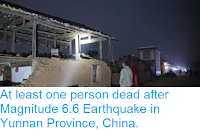Four people have been confirmed dead and another eight are missing following the collapse of a road tunnel during construction in the city of Lincang in Yunnan Province, China on Tuesday 26 November 2019. The event happened at about 6.00 pm local time, with part of the tunnel giving way and water and soft sediment rushing into the tunnel. One person was pulled out of the tunnel alive, who is now in hospital and described as being in a stable condition.
Rescue workers at the scene of a tunnel collapse in Lincang City, China, on 26 November 2019. Yan Hua/Xinhua.
The precise cause of the collapse is unclear, but it is likely that the tunnellers encountered a pocket of water or water-logged sediment during excavations. Photographs from the scene show significant amounts of grey mud in the tunnel, which is likely to be a sign of calcareous deposits, and local reports have spoken of ongoing flooding and weathered geology hampering rescue operations. This is likely to be indicative of a karst terrain, where limestone
is both soft and porous, and water from the surface sinks into it freely, permeating
through the rock and excavating caves through which the water flows. If the tunnel encountered or came close to a water-filled cave in such a terrain it is likely that the rock would collapse into the tunnel, leading to a flood.
A diagrammatic representation of how sinkholes and caves form in karst landscapes. Wisconsin Geological and Natural History Survey.
See also...
Follow Sciency Thoughts on Facebook.








